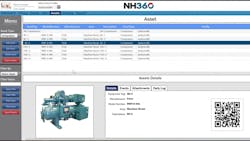3 benefits of digital process safety management
By now it is clear: We are living through a time of change and uncertainty. In the wake of the COVID-19 pandemic, businesses have had to adapt in new ways — and the food and beverage processing industry is no exception.
OSHA mandates personnel training and other process safety management (PSM) measures for processing facilities, and the agency’s rules and deadlines are still in effect. But in our post-COVID-19 world of social distancing, remote work and increased focus on public health, facilities are being forced to navigate unique challenges and new norms. [Note: At the time of writing this article, OSHA isn’t sending personnel to facilities unless an accident occurs, but process hazard analyses (PHAs), audits and site-specific training every three years are still required.]
So, what makes the most sense for processors right now? Digital PSM software. Compared to traditional analog methods, digital PSM provides key benefits that are more relevant today than ever before.
Improved safety
Mandated training, PSM audits and PHAs have historically involved site visits, but some of these activities can now be conducted remotely with a digital PSM program.
As we continue navigating the repercussions of the COVID crisis, many processing facilities are limiting who and how many people are allowed on their campus. Digital PSM software allows for audits, analyses and training to take place with little or no face-to-face contact in accordance with CDC guidelines.
Some facility walkthroughs can also be conducted virtually, with facility managers taking their engineering partners through the building via video conferencing on a smartphone or tablet. In addition, shifting to digital documentation reduces the amount of paper handling between facility decision-makers, outside engineers and any potential OSHA auditors.
Overall, switching to a digital PSM platform can mitigate health risks for a facility’s employees and engineering consultants, particularly in this post-pandemic environment.
Greater efficiency and accessibility
When it comes to site-specific training, a digital PSM platform can provide easier access to training for personnel and minimize disruption to your facility’s operations.
Rather than flying team members around the country and/or scheduling downtime for instruction, training can be conducted on demand via online software. Corporate safety personnel can also access and review documentation from their own office instead of traveling to the facility. Plus, fewer people visiting the site is one less distraction and makes life that much easier for owners and facility personnel.
Traditionally, PSM activities have relied on manual processes, such as:
- Printing paper documentation
- Completing and signing forms by hand
- Storing and keeping track of physical paperwork
However, a digital PSM platform streamlines the process and keeps facility stakeholders engaged. Schedules, notifications and automated reminders can be configured to keep owners on track.
Cost (and time) savings
Per OSHA standards, a PHA is mandated every five years. However, if you make substantial changes to your facility in between, a partial PHA may be required.
A partial PHA often requires flying out a specialist to the facility and paying for other travel expenses. Therefore, conducting these analyses remotely can yield significant cost savings for owners, when possible.
It is worth noting, however, that the standard five-year PHA is a comprehensive revalidation and is therefore a greater undertaking. While this analysis technically could be conducted remotely, it would be a big task, particularly for facilities that have undergone a lot of substantial changes.
Additionally, a digital PSM program saves time for facility operators. They can create training tasks within the software and assign them for employees to complete at their convenience. Owners can also set internal deadlines and automatic reminders to prevent a key measure from slipping through the cracks, and to ensure OSHA compliance.
Looking ahead to a new normal
The circumstances forced upon us by the COVID-19 outbreak are a reminder that we can’t rely on physical documentation and face-to-face interaction all the time — it is not a sustainable way to conduct a crucial business.
As essential members of our supply chain, food and beverage processors should be prioritizing safety and continuing operations despite the current challenges facing our economy.
Leveraging digital PSM technology is a simple way to improve public safety, increase efficiency, save time and save money. So, what is stopping you from making the switch?
Richard Boyd is the Director of PSM/Compliance and Claudio Feliciano is a NH360 specialist at Stellar, a fully integrated design, engineering, construction and mechanical services firm based in Jacksonville, Florida. Contact them at [email protected] and [email protected].
